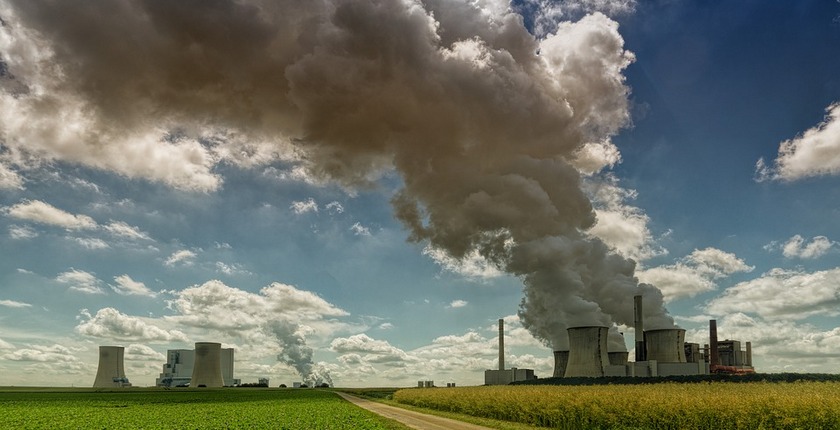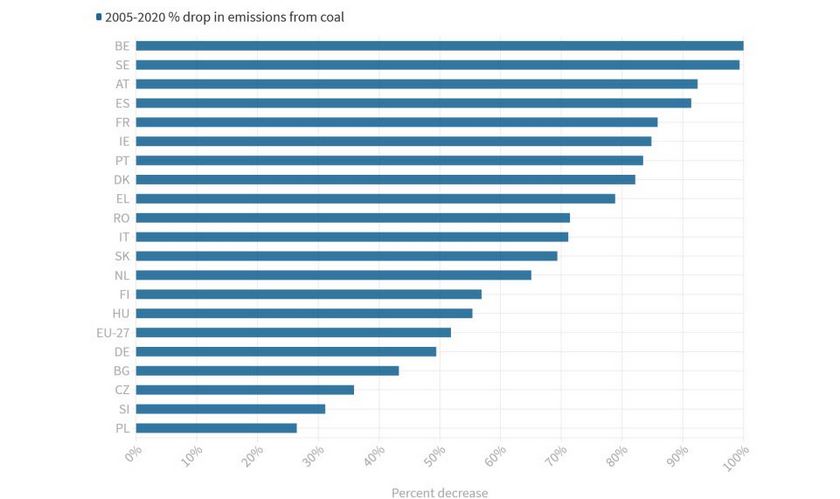
Photo: Pixabay/jplenio
Greece achieved a 56.3% reduction in emissions in all sectors covered by the European Union’s Emissions Trading System (EU ETS) in 2020 compared to 2005, the third best performance among the 27 EU member states. Slightly better results were recorded only in Denmark, which cut emissions in the ETS sectors by 58.3%, and Estonia, with a 56.4% reduction. However, Greece recorded the highest percentage cut in emissions from coal among the EU’s coal-producing countries, according to a study by Greek environmental think tank the Green Tank.
The reduction in the EU ETS sectors in Greece was largely due to the recent decline in lignite-based electricity generation, which cut CO2 emissions by 14 million tons in 2020 compared with 2018.
Among the EU coal producing countries, Greece recorded the greatest percentage cut in emissions from coal (including hard coal and lignite), of 78.9%. The emissions dropped from 43 million tons in 2005 to less than 9.3 million tons in 2020.
The reductions in the other major coal-producing countries in the EU were below the EU-27 average, with Germany recording a 49.4% decline, Bulgaria 43.3%, the Czech Republic 35.9%, and Poland 26.5%.
At the EU-27 level, the largest percentage decrease in coal emissions was achieved by Belgium, which phased-out coal completely by 2016, followed by Sweden and Austria, which did so in 2020.

The EU’s emissions from solid fossil fuels were reduced by 51.8% between 2005 and 2020, but most of this reduction took place during the 3rd EU-ETS phase, between 2013 and 2020, when lignite and hard coal plants were required to pay for CO2 emissions, leading to a 49.5% reduction of their emissions.
In the first years of EU ETS, hard coal was leading in emissions among solid fossil fuels, but lignite, which is a more polluting type of coal, later took the lead, and in 2020 accounted for 57.6% of the EU’s emissions from solid fossil fuels, according to the study.
The lignite emissions reduction in Greece was followed by an increase in emissions from fossil gas
However, the reduction of emissions from lignite in Greece was followed by an increase in emissions from fossil gas, of 44% in 2020 against 2013, as well as the presence of fossil gas units among the country’s 10 biggest emitters in 2020 for the first time since the kick-off of the 3rd phase of EU ETS in 2013.
Also, 2020 was the first year when Greek emissions from the energy-intensive industry surpassed those from lignite – 11.5 million tons compared with 9.2 million tons.
Greece needs to reduce the use of fossil gas and support the green transition of its energy-intensive industry
Phasing out lignite has put Greece in a climate leadership position, but the country needs to reduce its use of fossil gas and clearly support the green shift of its energy-intensive industry, according to Nikos Mantzaris, senior policy analyst at the Green Tank.
EU reduced ETS emission by 42.3% from 2005 to 2020
At the EU level, overall ETS emissions decreased by 42.3% from 2005 to 2020, slightly below the 2030 target, of 43%. The reduction was mainly due to the decline in emissions in the electricity and heat generation sector, and particularly from lignite and coal, while industry emissions remained relatively stable.
The Green Tank also noted that 2020 was an exception to these trends, as significant emissions reductions were seen in industry and aviation due to the COVID-19 pandemic.
Bold reforms are needed to ensure a 55% net emissions cut by 2030
According to Mantzaris, the EU ETS Directive is up for a revision in line with the Fit for 55 package, and bold reforms are needed to ensure that net GHG emissions are reduced by at least 55% by 2030 compared to 1990, not only at the EU level, but also in individual member states.
The study conducted by the Green Tank analyzed changes in GHG emissions in electricity and heat production, industry, and aviation, based on official data from the European Commission and the European Environment Agency.


















Be the first one to comment on this article.